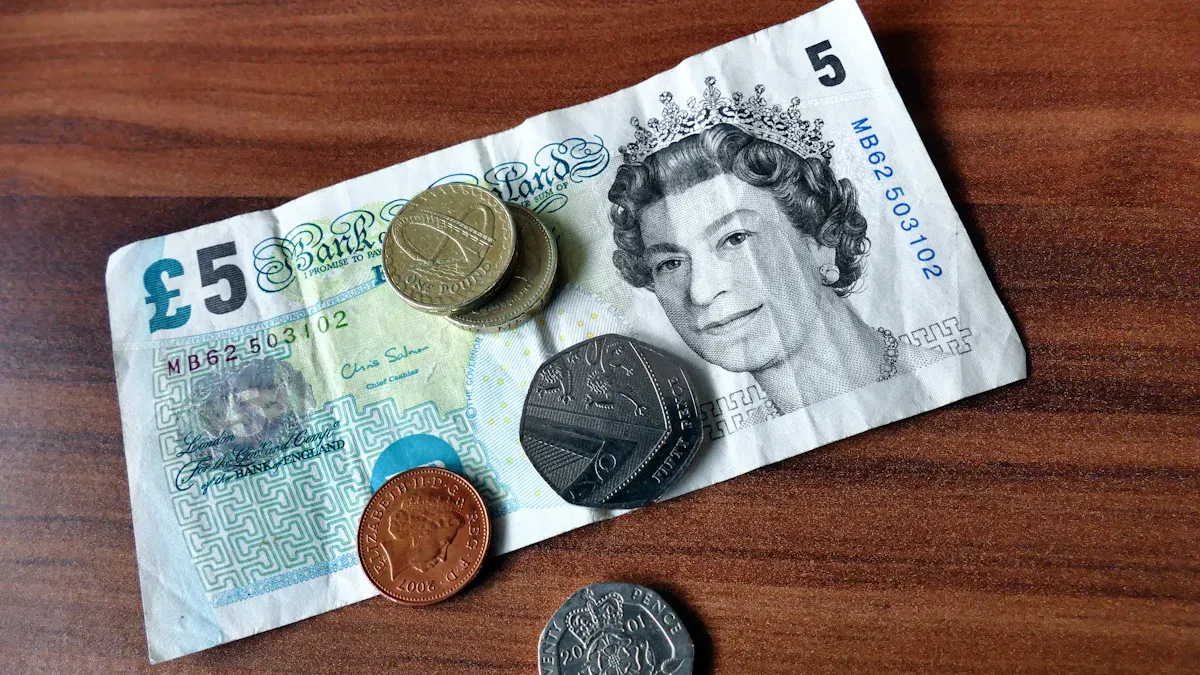- EasyCard
- Trade
- Help
- Announcement
- Academy
- SWIFT Code
- Iban Number
- Referral
- Customer Service
- Blog
- Creator
Converting British Pounds to US Dollars: An Analysis of the Best Ways to Remit Money from the UK to the US

Image Source: unsplash
If you’re planning to send money from the UK to the US for a transfer, modern online services like Wise or Revolut are the best transfer methods for most people. These platforms are easy to use and offer fast delivery.
Compared to the high fees and opaque exchange rates of traditional banks, these online platforms provide significant cost advantages.
Understanding the pros and cons of different options can help you make the most informed decision based on your transfer amount and speed requirements.
Key Takeaways
- Online platforms are the best choice for most people sending money from the UK to the US, offering low fees, transparent exchange rates, and fast delivery.
- Traditional banks and PayPal have higher transfer fees due to hidden exchange rate markups.
- When choosing a transfer method, compare total costs, delivery speed, and security.
- Before sending money, always verify the recipient’s bank account details, especially the correct routing number.
- When using online platforms, pay attention to the amount the recipient actually receives to avoid hidden fees.
Comparison of Main Transfer Methods

Image Source: unsplash
To help you find the most suitable transfer solution, we’ll compare four main categories: online transfer platforms, traditional banks, PayPal, and cash transfer services.
Online Transfer Platforms
For most personal transfers, online platforms are currently the best way to send money from the UK to the US. Services like Wise, Revolut, and Paysend have disrupted the traditional market with their low fees, transparent exchange rates, and fast speeds.
The biggest advantage of these platforms is that they typically use the “mid-market exchange rate,” the real rate you see on Google, charging only a small, transparent service fee.
- Wise (formerly TransferWise): Known for transparency and low fees. It clearly displays the fees, the exchange rate used, and the exact amount the recipient will receive.
- Revolut: Offers multi-currency accounts, making it very convenient to convert and transfer between currencies if you’re already a user.
- Paysend: Stands out with its innovative “card-to-card” transfer feature. You can send funds directly from your UK bank card to the recipient’s US bank card.
According to public data, these platforms are generally fast, though speeds vary slightly:
| Platform | Estimated Delivery Speed (GBP to USD) |
|---|---|
| Wise | Usually within 20 seconds to 2 business days |
| Revolut | May take 3-5 business days |
A notable feature of Paysend is its simple fee structure. For transfers from the UK, it charges a fixed £1 fee for card-to-card transfers, regardless of the amount. If transferring directly to a bank account, no transfer fee is charged.
Traditional Bank Wire Transfers
Using your local UK bank (e.g., HSBC, Barclays) for international wire transfers is a very traditional and secure method. If you need to transfer a very large amount (e.g., over £100,000), banks may be worth considering. However, for regular amounts, you need to be aware of their higher costs.
Bank fees typically consist of two parts:
- Explicit Fees: Include a fixed “handling fee” or “telegraphic transfer fee.” For example, when processing an international transfer at a branch, Barclays may charge a £25 fee.
- Hidden Costs (Exchange Rate Markup): This is the largest hidden fee. The exchange rate provided by banks is not the real mid-market rate but includes a markup. This difference is the bank’s profit.
The chart below shows the average exchange rate markup applied by some major UK banks for USD conversions.
For example, NatWest’s exchange rate markup can be as high as 4.6%. This means for every £10,000 sent, you could lose about £460 due to the exchange rate alone. This cost far exceeds the fees of any online platform.
In terms of speed, international wire transfers through banks typically take 1 to 5 business days to reach the recipient’s account in the US.
PayPal and Digital Wallets
PayPal is well-known for its convenience—you only need an email address to initiate a transfer. This ease of use is very appealing, but it comes at a high cost, especially for international transfers involving currency conversion.
PayPal’s costs come from two main sources:
- Transfer Fee: Sending personal international payments incurs a fee, typically 5% of the transaction amount, with minimum and maximum fee caps (e.g., up to £2.99).
- High Currency Conversion Fees: When converting GBP to USD, PayPal adds a markup of approximately 3% to 4% on top of the mid-market exchange rate. This fee is usually not explicitly shown but is included in the final exchange rate you see.
This markup hidden in the exchange rate is the most expensive part of PayPal’s international transfers. For a £500 transfer, you might lose an extra £15-20 compared to using Wise.
| PayPal Fee Structure (UK to US) | Description |
|---|---|
| Transaction Fee | 5% of the transaction amount (min £0.99, max £2.99) |
| Currency Conversion Fee | Approximately 4% markup on the mid-market rate |
| Payment Method Fee | Additional fees may apply if using a credit or debit card |
In summary, while PayPal transfers feel simple, they are among the most expensive options.
Cash Transfer Services
If you need to send money to a recipient without a bank account or in an emergency where they need cash immediately, cash transfer services like Western Union or MoneyGram come in handy.
- Advantages:
- Cash Pickup: Recipients can collect cash at tens of thousands of agent locations worldwide within minutes or hours with proper identification.
- Wide Coverage: Service points are widespread in both urban and rural areas, making them very accessible.
- Disadvantages:
- High Fees: Cash services typically have the highest fees among all transfer methods.
- Poor Exchange Rates: Their exchange rate markups are often significant, further increasing your total cost.
Thus, unless “cash pickup is a must” is your primary requirement, these services are not recommended for regular transfers.
Finding the Best Way to Send GBP to USD

Image Source: pexels
After understanding the pros and cons of different platforms, you need to choose based on your specific circumstances. To find the best transfer method, focus on three core factors: cost, speed, and security.
Key Considerations: Cost, Speed, and Security
- Cost: Total cost = fees + exchange rate losses. When comparing, don’t just look at the low fees advertised by providers; pay attention to the exchange rate they offer. The best transfer methods use a real exchange rate close to the mid-market rate.
- Speed: Is your transfer urgent? Delivery times vary significantly between services. Credit card payments are typically the fastest, while bank transfers take longer.
Transfer Method Average Delivery Time Online Platforms (Credit Card Payment) Usually instant or within hours Online Platforms (Bank Transfer Payment) 1 to 3 business days Traditional Bank Wire Transfer 1 to 7 business days - Security: Fund security is critical. Ensure the platform you choose is authorized and regulated by the UK Financial Conduct Authority (FCA). Reputable platforms use multiple security measures, such as:
- Data Encryption: Protects your personal and transaction data from being stolen during transmission.
- Multi-Factor Authentication (MFA): Adds an extra layer of security during login or transfers, such as through mobile verification codes.
Step-by-Step Guide: Using Wise as an Example
Using Wise as an example, you can see the complete process of making a transfer:
- Register an Account: You need to provide an email address, residential address, and upload identification (e.g., passport or driver’s license) to complete verification.
- Create a Transfer: Enter the GBP amount you want to send, and Wise will instantly display the USD amount the recipient will receive, the exchange rate, and all fees.
- Enter Recipient Information: Fill in the recipient’s name and bank account details.
Tip: U.S. bank accounts typically have two routing numbers: ACH and Wire. ACH routing numbers are for regular domestic transfers, while Wire routing numbers are for wire transfers. Be sure to confirm with the recipient which one to use to ensure smooth delivery.
- Choose Payment Method: You can pay for your transfer via bank transfer, debit card, or credit card. Payments with debit or credit cards are faster but may incur slightly higher fees, and Wise will clearly display all costs before payment.
How to Track Your Transfer
Modern online transfer services generally offer tracking features, allowing you to monitor your funds’ progress for added peace of mind.
After initiating a transfer, the platform provides a unique transaction ID or reference number. You can enter this number on the platform’s website or mobile app to check the transfer status. You’ll see updates like “Processing,” “Funds Sent,” and “Completed,” clearly showing the journey of your funds from leaving your account to reaching the recipient’s account.
Overall, for most personal transfers from the UK to the US, online platforms like Wise offer the best combination of cost, speed, and security.
Spending a minute comparing the “actual amount received” before each transfer is crucial. For example, for a £5,000 transfer, using a comparison tool can save up to 85% on fees.
You can flexibly choose the most suitable service based on the transfer amount, urgency, and recipient circumstances.
FAQ
What’s the Best Way to Transfer Large Amounts?
For most large transfers, online services like Wise remain cost-effective due to their fee caps and favorable exchange rates. For transfers exceeding £100,000, consult your bank’s premium services, but always compare their exchange rates with online platforms.
What Information Do I Need from the Recipient?
You typically need the recipient’s basic information and bank account details:
- Recipient’s full name
- Recipient’s full address
- U.S. bank account number
- Correct routing number
Important Note: Confirm with the recipient whether to use the ACH or Wire routing number, as using the wrong one may cause delays or failures.
How Can I Avoid Hidden Fees in Transfers?
To avoid hidden fees, choose services that use the mid-market exchange rate. Always check the “recipient’s actual received amount” before confirming the transfer. This figure accounts for all fees and exchange rate differences, reflecting your true total cost.
What’s the Fastest Way to Send Money?
Using online platforms and paying with a debit or credit card is typically the fastest method. Many transfers can be completed in minutes to hours. In contrast, direct bank transfers or traditional wire transfers take longer, usually 1 to 5 business days.
*This article is provided for general information purposes and does not constitute legal, tax or other professional advice from BiyaPay or its subsidiaries and its affiliates, and it is not intended as a substitute for obtaining advice from a financial advisor or any other professional.
We make no representations, warranties or warranties, express or implied, as to the accuracy, completeness or timeliness of the contents of this publication.




Contact Us
Company and Team
BiyaPay Products
Customer Services
is a broker-dealer registered with the U.S. Securities and Exchange Commission (SEC) (No.: 802-127417), member of the Financial Industry Regulatory Authority (FINRA) (CRD: 325027), member of the Securities Investor Protection Corporation (SIPC), and regulated by FINRA and SEC.
registered with the US Financial Crimes Enforcement Network (FinCEN), as a Money Services Business (MSB), registration number: 31000218637349, and regulated by FinCEN.
registered as Financial Service Provider (FSP number: FSP1007221) in New Zealand, and is a member of the Financial Dispute Resolution Scheme, a New Zealand independent dispute resolution service provider.



















